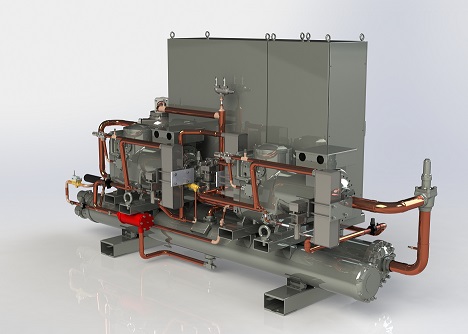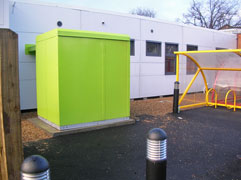How efficient is ground source energy?
Modern ground source heat pump installations can be very efficient. For each kilowatt of electricity used to run the heat pump, three to four kilowatts of heat can be transferred into the building. The efficiency of a GSHP installation depends on the quality of the design and installation. The efficiency of the installation is improved by utilising solar recharge of the ground.
The Coefficient of Performance ("CoP") of a heat pump system depends on the design and quality of the installation: from as low as 2 for an air source heat pump system in unfavourable conditions, up to 4 for an unassisted ground source heat pump, and up to 8 for a well designed ground source heat pump system benefiting from solar recharge of the ground.
How long have GSHPs been available?
GSHP systems are common in the North America, Sweden, Switzerland, France and Germany. The principles of heat pumps were first described by Lord Kelvin in the 1850s. Continuous development since they were first used commercially after the second world war has greatly improved their efficiency. GSHPs provide a proven, reliable, cost-effective, safe and environmentally friendly alternative to combustion-based heating.

Can ground source energy be used to heat older buildings?
Yes, but improving the insulation will be well rewarded, whatever the source of heat. The cost of a system is directly related to the heat losses, which will generally be higher in older buildings. Money spent on upgrading insulation levels can save a considerable amount on the capital cost of a ground source heat pump system. ICAX has recently installed ground source energy in Cambridge Terrace, Regents Park which was originally completed in 1825.
Can Ground Source Energy provide cooling?
Yes. Heat pumps deliver both heating and cooling very effectively. Cooling provided by heat exchange with cold ground is inherently more efficient than air conditioning which typically exchanges heat with hot air: renewable cooling.
The heating cost in winter will also be reduced if you are using cooling in summer as the heat pump will have access to warmer temperatures from the ground: renewable heating.

Does the heat distribution need to be enhanced for ground source energy in an old building?
Not necessarily. As heat pumps are more efficient at producing warmth at 50°C than heat at 65°C it can be advantageous to enhance the heat distribution system or install a new system such as underfloor heating. However, this can be disruptive. The alternative is to install a heat pump which is capable of delivering heat at 80°C, such as the example from ICAX on the right.
When a high temperature heat pump is installed in a retrofit installation it is important that the heat pump is controlled to produce the most efficient temperature: the heat pump can deliver 80°C when needed, but will be more efficient if asked to deliver a lower temperature when the outside temperature is mild.
Is underfloor heating a good idea?
Yes. Ground source heat pump systems are ideally matched to modern warm temperature underfloor heating because a heat pump transfers heat at a higher coefficient of performance if it delivers to a large warm water circuit (like underfloor heating) rather than a small high temperature circuit (like wall mounted radiators). However, ground source systems can equally feed heat (or cooling) to air handling systems or to fan coil units.
Can Ground Source Energy improve air quality?
Yes. Heat pumps deliver both heating and cooling without emitting any gases on site. All forms of combustion emit gases on site including NO2, SO2 and CO as well as CO2. Nitrogen dioxide, sulfur dioxide and carbon monoxide all contribute to respiratory problems when concentrations rise. All but two of London's boroughs are exceeding EU limits for nitrogen dioxide, a toxic gas linked to respiratory problems. See London Air Quality.
Are ground source heat pump systems suitable for well-insulated buildings?
Yes. All new buildings are designed to meet Building Regulations and should be able to benefit from a ground source heat pump. Building Regulations have been designed to conserve fuel, reduce heat losses and ensure greater energy efficiency, in order to ensure that all modern properties need less heating. For a well-insulated building the size of heat pump will be smaller, it will need smaller ground loops and will therefore be less expensive.
Are ground source energy systems sustainable?
Yes. There is now a strong move towards sustainable technologies that save on carbon emissions. 40% of UK CO2 emissions are derived from the heating and cooling of buildings. Using sustainable sources of energy to heat buildings reduces carbon emissions, particularly when compared to burning fossil fuels. The arguments are even stronger where a building needs cooling in summer as well as heating in winter. Ground source heating and cooling provides sustainable energy by recycling heat between seasons.
Ground source heat pumps use electricity which may be generated by carbon free resources like PV or hydro electric. Electricity usually comes from the Grid where a proportion is generated from power stations that burn fossil fuels. However, an efficient GSHP installation uses only a small amount of electricity to transfer a large amount of heat from the ground so running a GSHP releases less carbon than burning fuel directly. BEIS has plans to de-carbonise the Grid: the carbon released by electricity generation has already fallen by half since 2014 and BEIS predicts a steady decline over the years to 2035.
Energy Efficiency and Heat Recycling
The greatest energy efficiency is achieved when heat is collected in summer – as a by-product of cooling – and stored in the ground over the autumn for re-use to provide heating in winter. This is termed Seasonal Thermal Energy Storage and a ground source heat pump is a vital element in this form of heat recycling both in extracting heat in the summer and returning the heat in winter.
How large are ground source heat pumps?
A heat pump for a small building is the size of a large fridge. More powerful heat pumps for larger buildings do not increase in size or price as much as they do in power output.
Are Ground Source Heat Pumps safe?
There are no hazardous gas emissions, no flammable oil, LPG or gas pipes, no flue or chimney and no unsightly fuel tanks. GSHP systems have absolutely no site emissions. There are, therefore, no requirements for safety checks.
Are Ground Source Heat Pumps noisy?
No, a ground source heat pump makes less noise than a gas boiler, and very much less than an air source heat pump which drives a fan to extract heat from ambient air.
The cost of servicing and maintenance?
As with any valuable plant a ground source system should be covered by an annual maintenance agreement with the supplier. However, routine maintenance requirements are very low. A ground source heat pump can be expected to last well over 20 years – longer than a combustion boiler – and the ground heat exchanger should have a life of over 100 years.
Why are ground source systems known as "invisible heating systems"?
Ground source systems are automated. Because they come with low maintenance, low running costs, low noise and are out of sight, they are often referred to as invisible heating systems.
One key advantage of ground source systems is that they are favoured by planning officers: with nothing to hear, nothing to see, and nothing to smell there is nothing to object to.
How do running costs compare with conventional alternatives?
A ground source heat pump system can offer very high efficiency and low running costs. Oil-fired boilers cost considerably more to run. Even modern condensing gas boilers are more expensive to run at current gas prices, with gas prices also set to rise. All fossil fuel boilers need regular servicing to maintain efficiency and check safety.
What about alternative heat sources for heat pumps?
A ground source heat pump uses a ground loop or borehole to exchange heat with the ground: the advantage is that a relatively constant temperature is available throughout the winter if the ground loop is large enough. There are alternatives which can also be attractive for larger buildings including open loop systems which heat exchange with open water or aquifer systems: water source heat pumps or marine source heat pumps. It is also possible to heat exchange with ambient air, but an air source heat pump is significantly less efficient when the external air temperature is cold - and this corresponds with the time when space heating is most needed.
What are the costs of installing a ground source heat pump?
The initial purchase cost of a ground source heat pump system is more than a conventional oil or gas fired boiler. The initial capital expense is offset by lower running costs, lower maintenance and low servicing requirement. There is also the security of knowledge that the majority of your heating and cooling energy comes from the ground and will not increase in price.
Be careful to avoid judging an installation on price alone. It is very important to ensure you have a well designed system if your aim is to save money over the initial years of the life of the installation.
Are grants available to reduce costs further?
Yes. TheBoiler Upgrade Schemegrant makes a £6,000 contribution to the capital cost of installation, and the running costs and maintenance costs are each lower than for other heating systems.
Are ground source heat pumps suitable for district heating?
Yes. A communal ground array serving a heat pump in each building has many advantages over a traditional Combined Heat and Power district network including lower installation costs, lower running costs, much lower carbon emissions and improved air quality. See use of heat pumps in district heating.
Conclusion
Ground source heat pumps work best when used in a well designed installation to balance the heating and cooling needs of a building over the seasons. A GSHP can do this by transferring heat to or from the ground it stands on to achieve a well moderated temperature in the building all year round: Joined-up heating.
Contact ICAX
We prefer to work in conjunction with architects and M&E consultants from the earliest stage to ensure that there is a clear understanding of how we can help to deliver a sustainable building with a high carbon offset.
Please email enquiries to
or give us a ring on 020 7253 2240.
Ground Source Heating Ground Source Cooling Ground Source Energy



